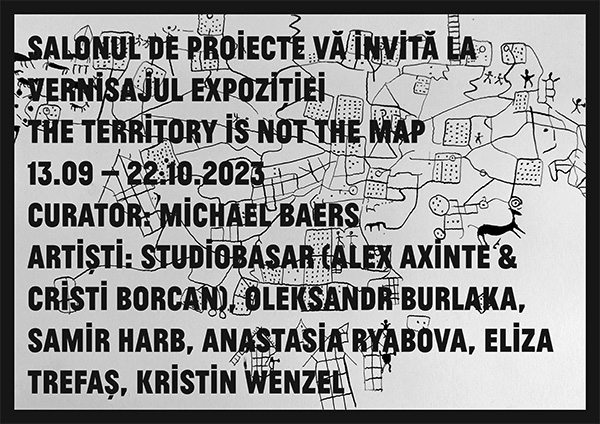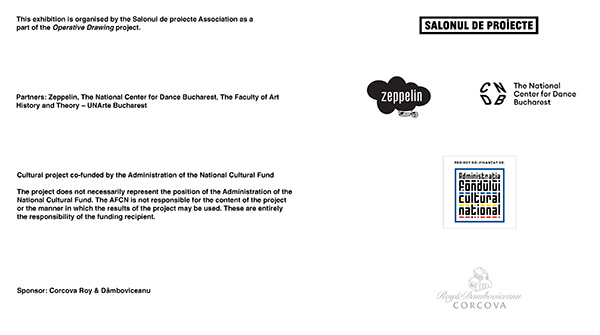THE TERRITORY IS NOT THE MAP
13.09.2023 - 22.10.2023
Artists: studioBASAR (Alex Axinte & Cristi Borcan), Oleksandr Burlaka, Samir Harb, Anastasia Ryabova, Eliza Trefaș, Kristin Wenzel (with Bogdan Bălan, Alice Gancevici & Remus Pușcariu, Dana Andrei, Maria Persu)
Curator: Michael Baers
Opening: Wednesday, September 13, 19.00
18.30 & 19.30 - short picnic sessions initiated by Eliza Trefaș, during which visitors are welcome to engage or just observe (departure from Salonul de proiecte to Regina Elisabeta Boulevard)
19.00 - opening | curator Michael Baers will present the works showcased in the exhibition.
Drawing is perhaps the first medium humanity used to create plastic representations of the world, and its ubiquity remains with us, in the doodles we scribble while talking on the phone, to the sketches we employ to work out all manner of problems, both abstract and concrete. Drawing has a capacity to represent (or figurate), but also to diagram, to map, to script, or notate. This scope of use, from the purely diagrammatic to the spontaneous and expressive, makes it the medium closest to thinking, but also the one with the broadest medial range, from drawing using a stick in the dirt to drawing with sophisticated computer software. Drawing, as the French philosopher Jean-Luc Nancy has noted, “participates in a semantic field where act and force [puissance] are combined, or where the sense of the act, the state, or the being that is in question cannot be detached entirely from a sense of gesture, movement, or becoming.” The exhibition The Territory Is Not the Map, which takes its title from a saying attributed to the American engineer Alfred Korzybski—reversing his original truism to point to the constitutive function of drawing in shaping the human world—has collected examples of drawing that allude to its role in creating or destroying the urban landscape, under both wartime and peacetime conditions, and to also show how drawing can serve as an instrument of policy or an instrument of resistance.
Drawing is fundamentally constitutive of the modern city and ubiquitous within it. The plans rendered by architects and urban planners create the terrain urban dwellers must navigate, while signage and graffiti present a second-order of signification upon the city’s built environment. In our current historical moment, there is a clear imperative in exploring the shared logics undergirding these two opposed subject-positions. What connects the top-down plan-making of the architects and urbanists who create new city developments from scratch or radically transform historical city-centers and the bottom-up marks of contestation made by graffiti writers who use drawing to mark out urban space? The Territory Is Not the Map looks at some conceptual homologies that link the creative destruction of cities through, say, urban renewal, to the destruction of cities by military aggression, as well as the close yet occulted relationship of drawing to the creation or contestation of urban space: as a way of organizing and constructing space, and as a means of expression and/or contestation within urban space.
Following this argument, The Territory Is Not the Map is not limited to drawings per se, instead including works that explore the relationship between planning and executing, place-making and place-destroying. The Bucharest-based architectural practice studioBASAR (Alex Axinte & Cristi Borcan) will show working drawings taken from their urban research. Artist and architect Oleksandr Burlaka (who also designed the exhibition’s central viewing hub) will present documentation of written messages left by Ukrainians on burnt-out Russian military vehicles. Graphic novelist and geographer Samir Harb presents a fragment of a longer work on the Mukataʿa in Ramallah, the administrative center built by the British during the Mandate Period, which became the center of the Palestinian Authority administration during the Oslo period before being substantially destroyed by the Israelis during the Second Intifada. Artist Anastasia Ryabova will present a newly realized work involving the creation of a large-scale geometrical figure that links architectural objects in Bucharest. Dance and performance artist Eliza Trefaș will also present a new work addressing the increasing loss of vital green spaces in Bucharest, particularly the ongoing conflict over the privatization of the IOR park area. Finally, German artist Kristin Wenzel will show five decorative building fragments from the collection she has amassed during walks through Bucharest, poetically annotated by herself as well as friends and colleagues (Bogdan Bălan, Alice Gancevici and Remus Pușcariu, Dana Andrei, and Maria Persu)—a work that both draws on how built space is articulated locally and also a kind of mapping project charting historical processes of civic neglect. As for Michael Baers, he has chosen to muddy the distinction between artist and curator by presenting the exhibition text as a largescale poster work.
While The Territory Is Not the Map takes place in Bucharest and some of the contributing artists and researchers take aspects of the city as their subject, it is important to note that the processes of demolition and refunctioning that have transformed Bucharest share homologies with other large cities. The exhibition’s interest is in attending to global processes of transformation within their local articulations by focusing on drawing—the medium that while essential disappears in the process of making both the largest of buildings and the smallest of insights.
This event is organised by the Salonul de proiecte Association as a part of the Operative Drawing project.
Partners: Zeppelin, Centrul Național al Dansului București, Facultatea de istoria și teoria artei – UNArte București
Sponsor: Corcova Roy & Dâmboviceanu
The project does not necessarily represent the position of the Administration of the National Cultural Fund. The AFCN is not responsible for the content of the project or the manner in which the results of the project may be used. These are entirely the responsibility of the funding recipient.





